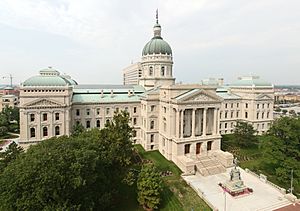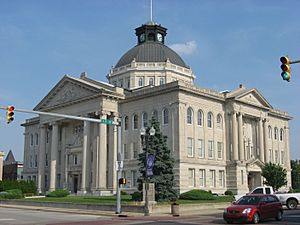Government of Indiana facts for kids

|
|
| Part of | United States of America |
|---|---|
| Constitution | Constitution of Indiana |
| Legislative branch | |
| Name | General Assembly |
| Type | Bicameral |
| Meeting place | Indiana Statehouse |
| Upper house | |
| Name | Senate |
| Presiding officer | Micah Beckwith, President |
| Lower house | |
| Name | House of Representatives |
| Presiding officer | Todd Huston, Speaker |
| Executive branch | |
| Head of State and Government | |
| Title | Governor |
| Currently | Mike Braun |
| Appointer | Election |
| Cabinet | |
| Leader | Governor |
| Deputy leader | Lieutenant Governor |
| Headquarters | Indiana Statehouse |
| Judicial branch | |
| Courts | Courts of Indiana |
| Supreme Court of Indiana | |
| Chief judge | Loretta Rush |
| Seat | Indianapolis |
The government of Indiana is set up and guided by the Constitution of Indiana. The state government has three main parts: the judicial branch (courts), the legislative branch (lawmakers), and the executive branch (governor and others). These three parts share power and work together to run the state of Indiana.
Local governments, like those in counties, cities, and towns, are also part of the system. They have limited power to collect taxes, make local rules, and build and maintain public services.
Indiana's government first started in December 1816, replacing the government of the Indiana Territory. Early on, people thought it wasn't working well. Many jobs were given out instead of being elected, and even small things like divorces needed state approval. In 1851, a new constitution was adopted. This fixed many of these issues and allowed more people to vote for their leaders. Big changes happened again in 1971 when the state courts were reorganized. Also, the governor, who used to have less power, was given more.
Elections for jobs in Indiana's government happen on Election Day. Sometimes, special elections are held to fill unexpected empty spots. State representatives serve for two years. All other elected state, county, and city officials serve for four years. Elections are spread out, so you can vote almost every year, not just every two years. Many government jobs are filled based on skill or sometimes by connections.
The government offers many services to its citizens. These include keeping laws, building and fixing roads, giving out licenses, collecting taxes, fire safety, and taking care of parks.
Contents
How Indiana's Government Works

The government of Indiana is located in the state capital, Indianapolis. Each of the three main parts works out of the Indiana Statehouse. The state also has other office buildings for its many departments. Most of these offices are in the Indiana Government Center. This is a group of buildings in downtown Indianapolis, right next to the Statehouse.
The Lawmakers (Legislative Branch)
The Indiana General Assembly is the part of the government that makes laws for Indiana. It has two parts: the Indiana House of Representatives (lower house) and the Indiana Senate (upper house). The General Assembly meets every year at the Indiana State House in Indianapolis.
Members of the General Assembly are chosen from specific areas called districts. These districts are redrawn every ten years. Representatives serve for two years, and senators serve for four years. Both the House and the Senate must agree on a bill before it can go to the governor to become a law.
The Courts (Judicial Branch)
The Indiana Supreme Court is the highest court in Indiana. It oversees all the lower courts and groups that make up the judicial branch. Other courts include the Indiana Tax Court, the Indiana Court of Appeals, and local circuit, superior, and city or town courts. Every county has a circuit court where many types of lawsuits can be filed. Larger cities also have courts that act as superior or municipal courts.
The Governor and Executive Branch
The Governor of Indiana is the main leader of the state government. The governor is elected for a four-year term. Their job is to manage the daily operations of the state government. Other elected officials help the governor, including the Lieutenant Governor and the Attorney General.
Currently, Eric Holcomb (R) has been the Governor since 2017. Suzanne Crouch (R) has been the Lieutenant Governor since 2017. Todd Rokita (R) has been the Attorney General since 2021. Diego Morales (R) has been the Secretary of State since 2023. Daniel Elliott (R) has been the Treasurer since 2023. And Elise Nieshalla (R) has been the Auditor since 2023.
How Power is Balanced (Checks and Balances)
Indiana's Constitution has rules called "checks and balances." These rules stop any one part of the government from becoming too powerful. For example:
- The governor can say "no" (veto) to any bill passed by the General Assembly.
- But the General Assembly can still make the bill a law if most members vote to override the veto.
- Courts can say a law is against the Constitution and stop it.
- However, the General Assembly can start a process to change the Constitution to get around the court's decision.
- Indiana judges are chosen by a special group that includes people picked by the governor and the courts.
- The General Assembly can also make rules about what types of cases the courts can hear.
Local Governments in Indiana
County Governments

County Council: A county council, with seven or nine members, controls all the money spent and collected by the county government. Each county decides if council members are elected from the whole county or from smaller areas. Council members serve four-year terms. They set salaries, the yearly budget, and approve special spending. The council can also collect some local taxes, like income taxes (with state approval) or taxes on dining or lodging.
Board of Commissioners: This is the executive part of the county government, with three commissioners. They are elected by the whole county and serve four-year terms, usually at different times. One commissioner, usually the most experienced, acts as president. Commissioners carry out the rules made by the council and manage the county's daily operations.
Boards and Commissions: Counties also use different boards and commissions to manage specific areas. Members of these boards can be elected by the public, chosen by the Board of Commissioners, or both. These groups often manage water systems, roads, and new projects. For example, each school district has a board, whose members are elected. County school boards are in charge of funding and running public schools in their area. Most school money comes from property taxes, which have state limits.
Courts: Every county has its own circuit court, as required by Indiana's Constitution. Some counties have more courts. Circuit and superior courts handle many different types of cases. Some counties, like Marion County, also have special small claims courts, plus city and town courts with specific powers.
County Officials: Counties have several other elected officials. These include a sheriff, coroner, auditor, treasurer, recorder, surveyor, and circuit court clerk. Each of these officials serves a four-year term and manages a different part of the county government. People running for county jobs must say which party they belong to and must live in that county.
Town Governments
Many small communities in Indiana are set up as towns. A town has a three or five-member town council. This council mainly makes the town's rules. For practical reasons, the council might also handle some daily management tasks. However, the head of the town council is the main executive officer. This president is an elected council member chosen by the other council members. The council can also hire a non-political town manager to oversee the town's daily operations. The council sets the town's budget and tax rates, and hires all town employees. Unlike some states, Indiana town council members must say which political party they belong to when they run for office. Indiana towns also elect clerk/treasurers, who manage the town's money. As elected officials, clerk/treasurers work independently of the town council, but they must stay within the council's approved budget.
City Governments
Most larger communities are set up as cities. Cities can be "third-class" or "second-class" (the "first-class" title is only for Indianapolis). Cities are classified by Indiana law, mainly based on their population. Large cities are first-class, medium cities are second-class, and small cities are third-class. An Indiana city has a mayor-council form of government, but a third-class city can hire a city manager. The mayor, elected for a four-year term, is the executive leader. Most mayors in Indiana are elected in party-based elections. The lawmaking part is a city council with five, seven, or nine members. Council members serve four-year terms and can be elected from specific areas or by the whole city. Most cities in Indiana use specific areas.
Township Governments
A township trustee manages the local government of a township. The trustee is elected by the people living in the township for a four-year term. The trustee is responsible for providing fire and ambulance services to areas not part of a city or town. They also help people in need, maintain cemeteries, solve fencing problems between neighbors, investigate claims of livestock killed by dogs, control weeds, manage the township's money, and prepare a yearly financial report. The trustee also acts as the property tax assessor. Trustees might also be involved in things like zoning, parks, libraries, schools, and community centers.
A three-member Township Board helps the trustee. Its members are elected for four-year terms. The board's jobs include approving the yearly budget, acting as a finance board, and approving township contracts. In January each year, the trustee gives the board a report showing the township's money coming in, going out, investments, and debts. This approved report is then published in local newspapers for everyone to see.
Indiana's Political Landscape
Indiana is often seen as a strong Republican state. The current governor of Indiana is Republican Eric Holcomb. Republicans also have a very large majority in both parts of the Indiana General Assembly. Since 1912, Indiana has only voted for a Democrat for president four times: in 1932, 1936, 1964, and 2008. Historically, the state used to be a "swing state," meaning it often voted for the winner of the national election.
However, half of Indiana's governors in the 20th century were Democrats. Indiana has also elected several Democrats to the Senate in recent years. Some cities, like Gary, Indiana, tend to vote for Democrats; Gary has had a Democratic mayor for the last 77 years. While only five Democratic presidential candidates have won Indiana since 1900, 11 Democrats were elected governor during that time. Before Mitch Daniels became governor in 2005, Democrats had held that office for 16 years in a row. Since then, Republicans have consistently held the governor's office. Democrats also generally controlled the Indiana House of Representatives in the 1990s and 2000s.
Historically, Republicans have been strongest in the eastern and southern parts of the state, and in the areas around major cities. Democrats have been strongest in the northwestern and central parts of the state, including the major cities themselves. However, outside of Indianapolis, the Chicago suburbs, and Bloomington, Indiana's Democrats tend to be more conservative than Democrats in other parts of the country, especially on social issues.
Indiana's group of representatives in the United States House of Representatives is not always all Republican. Instead, it has often shown how the country's politics are changing. For example, Democrats held most of the seats until the "Republican Revolution" in 1994, when Republicans gained the majority. This continued until 2006, when three Republican congressmen from Indiana lost their elections. This gave Democrats the majority of the delegation again.
See Also
- Politics of Indiana
- Governor of Indiana
- Indiana General Assembly
- Indiana Supreme Court
- Constitution of Indiana
- Political party strength in Indiana

